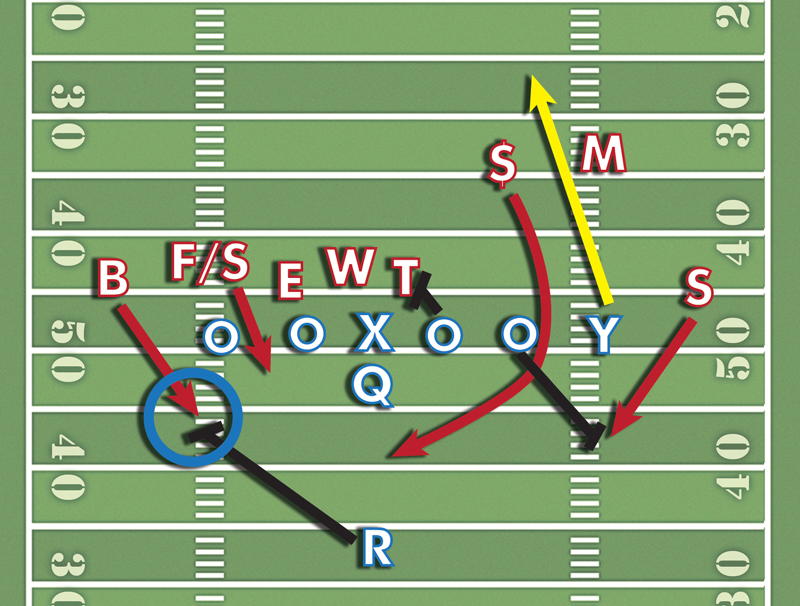Last Saturday night in Corvallis, Oregon State fielded the nation’s finest pitch-and-catch duo, the explosive combination of junior quarterback Sean Mannion and junior receiver Brandin Cooks. The Cardinal promptly held the Beavers passing attack to a decidedly anemic 3.25 yards per play (counting sacks).
The Cardinal defense triumphed because Stanford absolutely annihilated Oregon State’s offensive line, recording eight sacks and five other tackles for loss in an extravaganza of Beaver pain and destruction. Mannion gained a lot of respect in Stanford fans’ eyes for his tough performance, but unfortunately for the Beavers, points are gained for scoring and not for style.
Early in the game, Stanford used all sorts of blitzes to crush the Beaver offensive line, and in this play the Cardinal creatively brought the house.
A long fumble return had given Oregon State great field position, and the Cardinal needed to generate a stop. Backed up at its own 17-yard line and with little to lose, the Cardinal was able to play pure man coverage and blitz its last safety. After Oregon State sent its tight end (Y) into a pass pattern against fifth-year senior linebacker Shayne Skov (M), Stanford had seven blitzers against the Beavers’ six remaining blockers. (The diagram omits the remaining players for clarity.)
Before the snap, Stanford allowed its players to move around, disguising its defensive strategy. As Mannion went into his snap count, senior free safety Ed Reynolds (F/S) positioned himself at the line of scrimmage. Ideally, Oregon State would have used its big senior left tackle Michael Philipp to block Stanford’s fifth-year senior linebacker Trent Murphy (B) and shifted junior running back Terron Ward (R) to block Reynolds, but Reynolds’ sudden move to the line forced Philipp to make a snap decision and cover Reynolds instead. The numbers were still two-on-two, which nominally favored the Beavers, but the 5-foot-7, 202-pound Ward was not going to hold up the 6-foot-6, 261-pound Murphy for long. (See the blue circle.) Mannion would not get blindsided immediately, but he would not have all day either.
“Not all day” was still likely too much time against the Beavers’ dangerous receivers, and Stanford had to get a blitzer free with a full head of steam before Mannion found an open man. If Oregon State could direct Stanford’s free blitzer to the outside where he would have a long path to the quarterback, Mannion would have time to throw. However, the blitz Stanford called actually opened up an interior gap in the Beaver line for the crashing safety Jordan Richards ($).
The Cardinal was lined up in the “Bear” defensive front (a front being an alignment of the defensive line), which placed three defensive players directly opposite Oregon State’s three interior offensive linemen. By forcing one-on-ones against interior linemen and especially the center, typically not a pass protection specialist, the Bear generated enormous pressure against the quarterback.
Most importantly, by placing its biggest defensive player, senior defensive tackle David Parry, to the left of the right guard, Stanford ensured that said guard would have to turn his hips and commit to blocking left, leaving him unable to help to his right. Stanford also aligned senior linebacker Joe Hemschoot (S) in a pure pass-rushing wide-nine technique, forcing Oregon State’s right tackle to take several steps right to block him. The result was a hole between the guard and tackle that you could quite literally drive a car through, which left junior Jordan Richards ($) free to take target practice at Mannion.
Stanford got two schematic successes on this play, although it was actually fifth-year senior defensive end Ben Gardner (E) who superbly beat the slide protection to sack the quarterback. Mannion was hit in less than two seconds. When Gardner sacked the beleaguered Mannion, Richards was right there with him, and Murphy not far behind. Defensive penetration had the relatively immobile Mannion under constant pressure, and it’s to Mannion’s credit that he managed to finish the game.
The Bear has its vulnerabilities, and very few coaches will use it as their base defense, although New York Jets coach Rex Ryan is famous for creatively blitzing from this front. But the Bear front is effective against certain forms of the run game as well, and this latter advantage is what makes it such a critical element of Stanford’s game plan against the Oregon Ducks rushing attack…the subject of this column’s upcoming bye-week edition.
Contact Winston Shi at wshi94 ‘at’ stanford.edu.

